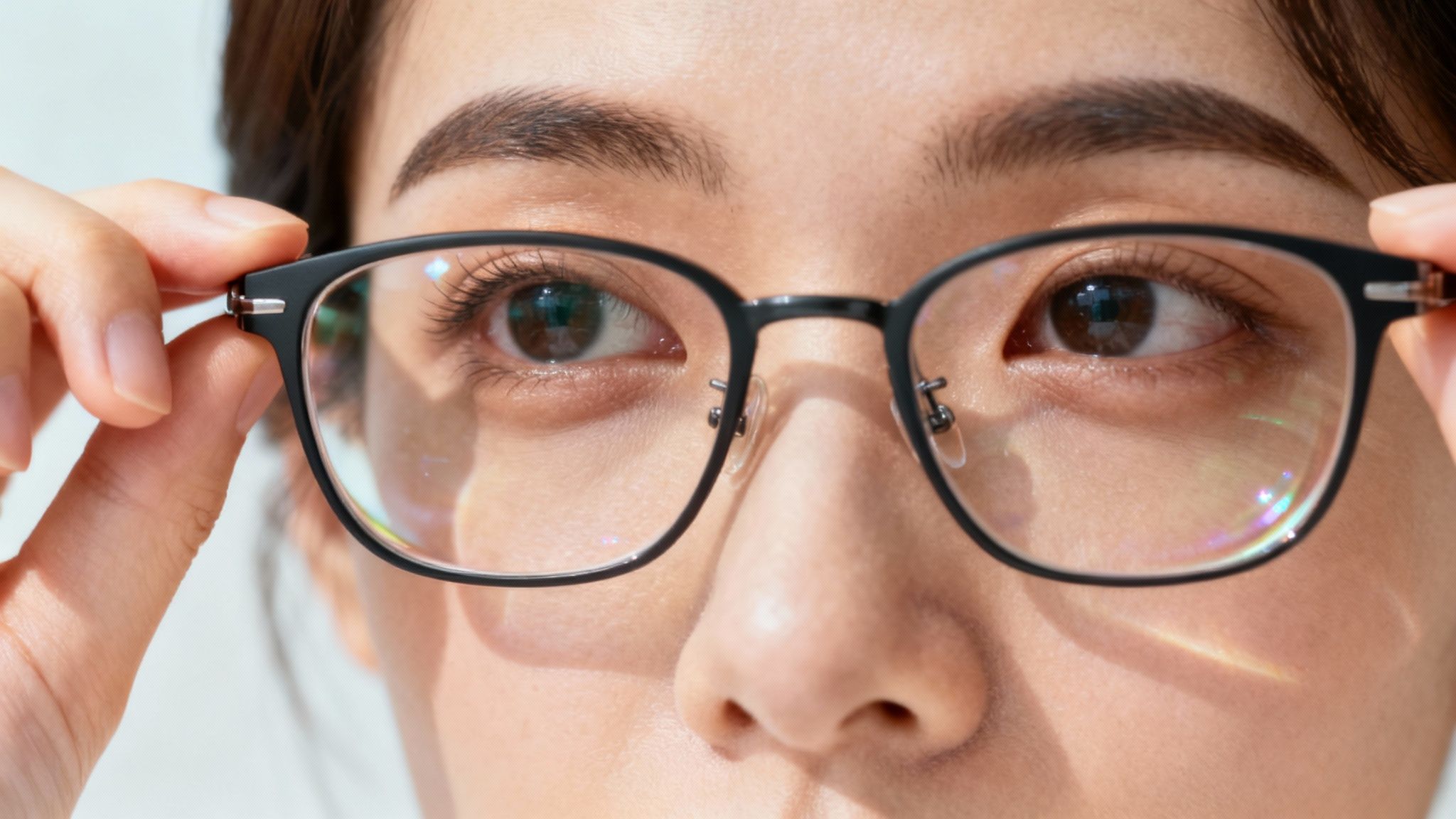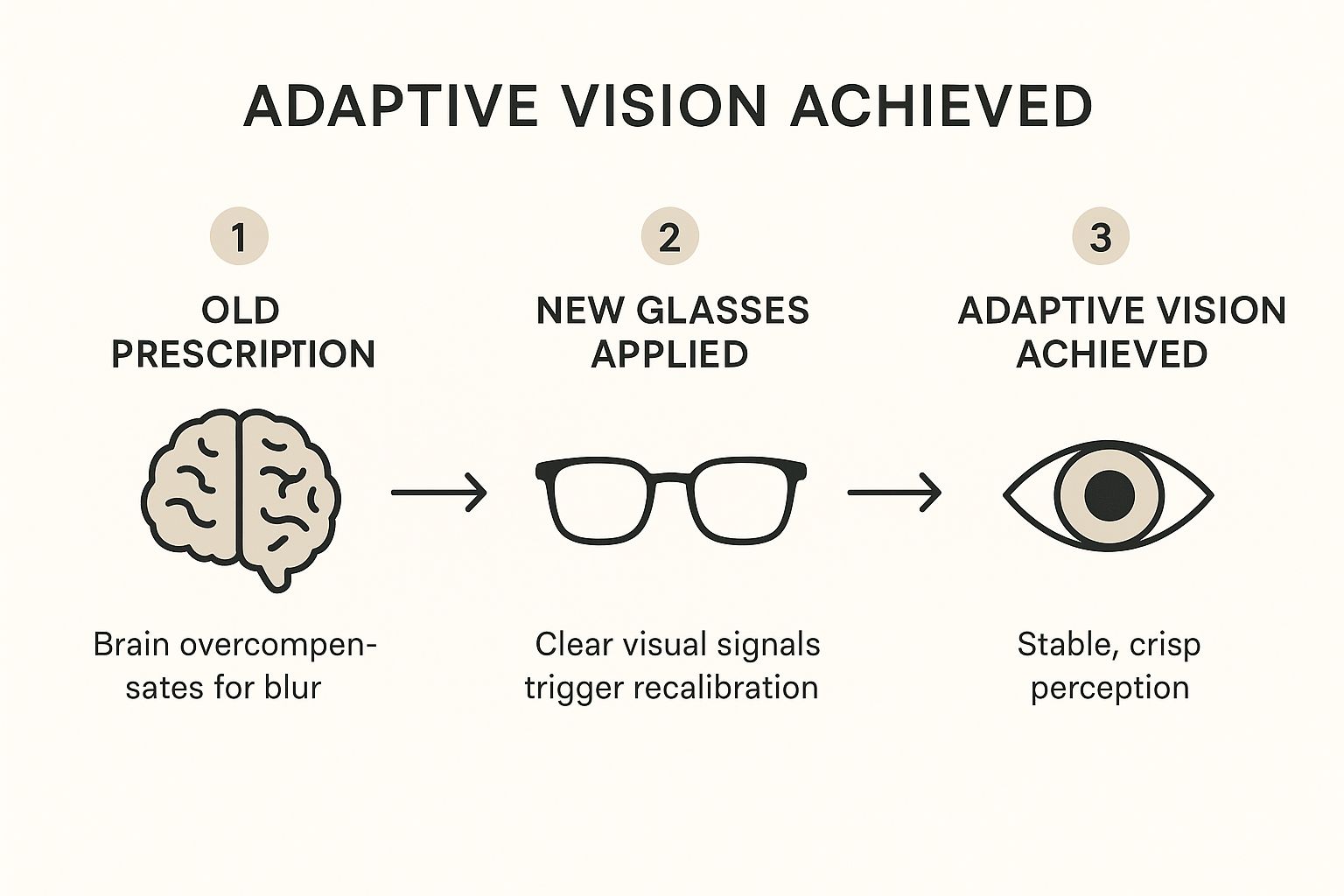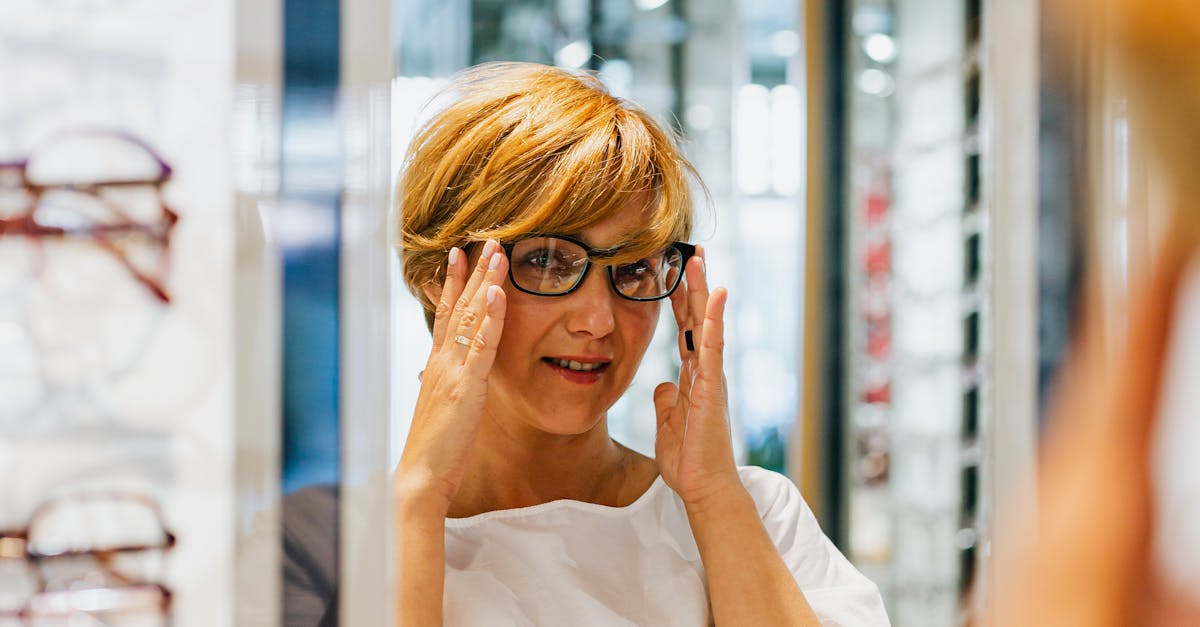That exciting moment when you first put on a new pair of glasses can also feel… a little strange. It's totally normal. Things might look a bit "off," you could feel some mild eye strain, or you might notice the infamous "fishbowl effect." For residents of Glendale Heights and the surrounding Chicagoland suburbs, getting that perfect pair of designer eyeglasses from iDoctor is the first step toward clearer vision.
This is just your brain and eyes working together to get used to a much clearer view of the world. For a long time, your brain has been compensating for an old, weaker prescription. Now, it needs a little time to recalibrate.
Why Your New Glasses Feel a Little Off
Here at iDoctor, your local optometry boutique in Glendale Heights, we know that finding the perfect eyewear is just the first step. The adjustment period is a nearly universal experience, and understanding why it happens makes the whole process easier. You're certainly not alone—around 75% of adults worldwide use some form of vision correction.
Think about it: for months or even years, your brain has been working overtime to interpret the blurry images from your old glasses. When you finally put on a new, perfectly corrected pair from our curated collection—whether it's Cartier or Ray-Ban—your brain is still stuck in that "overdrive" mode. It needs to unlearn its old habits and start trusting the crisp, clear information it's now getting from your eyes.
Common Sensations During Adjustment
This recalibration phase can bring on a few temporary symptoms. Don't worry, these are signs that your visual system is actively adapting to the new and improved input.
- Mild Eye Strain or Headaches: The muscles in your eyes are simply learning to work differently to focus through the new lenses, which can cause a bit of fatigue at first.
- The "Fishbowl Effect": You might notice that objects look slightly curved or distorted at the edges of your vision. This is especially common if you've had a significant prescription change or switched to a different frame style.
- Altered Depth Perception: A classic example is when stairs seem steeper or the floor looks closer than it actually is. Your brain is just relearning how to judge distances accurately with its new, sharper input.
Key Takeaway: These feelings are usually mild and should disappear within a few days to two weeks. It's all part of the process!
Common Sensations and What They Mean
Here's a quick look at what you might feel as your eyes and brain adapt.
| Symptom | What It Feels Like | Why It Happens |
|---|---|---|
| Eye Strain | A tired, achy feeling in your eyes, sometimes leading to a headache. | Your eye muscles are adjusting to a new way of focusing. |
| Fishbowl Effect | The edges of your vision seem bent or warped, like looking through a bowl. | Your brain is getting used to the new lens curvature and prescription strength. |
| Depth Perception Issues | Objects appear closer or farther away than they actually are. | Your brain is recalibrating its spatial awareness based on the new visual data. |
With a little bit of patience, you'll soon be enjoying comfortable, crystal-clear vision, whether you're driving down Bloomingdale Road or just reading a book at home.
Sometimes, screen time can amplify these feelings, especially if you're dealing with Computer Vision Syndrome. A perfect fit is also crucial for a smooth transition, which is why precise measurements are so important. We go into more detail about how we get that perfect fit in our guide on digital optical measurements for the perfect eyeglass fit.
The Science Behind Your Brain's Adjustment Period
Your brain and eyes have a surprisingly complex relationship. For months, maybe even years, your brain has been quietly working overtime, compensating for the blurry vision from your old glasses. It got used to filling in the gaps to give you a clear-enough picture of the world around you.
Now, you've introduced a brand-new, crystal-clear prescription. But your brain is still stuck in its old "compensate" mode. It literally has to unlearn its old habits and start trusting the sharp, new information it's receiving. This recalibration is what causes those temporary, weird feelings with depth perception or even your peripheral vision.
Why Your Brain Needs to Recalibrate
I like to compare it to breaking in a new pair of hiking boots. They're the right size and technically perfect, but they feel stiff and strange at first. Your brain is doing the exact same thing—breaking in a new, clearer way of seeing. Knowing that this is a normal neurological process can make those initial strange sensations feel a lot less alarming. For a deeper look at what to expect, check out our guide on how long it typically takes to get used to new glasses.
It's also worth noting that more people are going through this than ever before. As the population ages, conditions like presbyopia are on the rise. In fact, about 90 million people over 40 in the U.S. deal with vision issues that often lead to bifocals or progressives, which require an even more complex adjustment from the brain. You can learn more about this trend in this detailed eyewear market report.
This "neuro-adaptation" phase is a perfectly normal and healthy sign. It means your brain is actively responding to the sharper visual input from your new lenses.
Understanding how our brains process and adapt to new visual information is key, whether it's a simple prescription change or navigating more significant challenges. For those interested in how technology can help with various visual needs, resources on Text To Speech – Visual Impairment offer some fascinating insights.
This entire adjustment process really highlights why we put so much care into the detailed eye exams we offer here in Glendale Heights. A precise prescription is the perfect starting point for your brain's journey.
Practical Ways to Speed Up Your Adjustment
So, you want to get used to your new glasses faster? The single best piece of advice I can give is to go all in. Start wearing them the minute you get up and keep them on until you go to bed.
I know it's tempting, but try not to switch back and forth with your old pair. Every time you do, you're hitting the reset button on your brain's adjustment process, which just drags everything out.
Create a Comfortable Environment
It's a good idea to spend the first day or two in a familiar space, like your home. Your brain is relearning depth perception and spatial awareness, and it's much easier to do that walking through your own kitchen than, say, navigating a busy street like North Avenue. Once you feel steady on your feet, you'll be ready to take them anywhere.
A poor fit can also make the adjustment feel way worse than it needs to be. If your glasses are constantly sliding down your nose, it's just plain annoying. Thankfully, this is often an easy fix. We have a whole guide on how to adjust glasses arms that can walk you through it.
The whole point is to make your new glasses feel completely natural, like they're just part of you. Consistent, full-time wear is the quickest path to getting your brain to fully embrace that new, sharp view of the world.
If you're a student at Glenbard North High School or just someone who spends a lot of time staring at a screen, eye strain is a real challenge during this break-in period. This is where the 20-20-20 rule comes in handy:
- Every 20 minutes, take a break from your screen.
- Find an object about 20 feet away.
- Focus on it for at least 20 seconds.
It’s a simple trick, but it really works. It gives your eye muscles a little breather and helps cut down on that tired, strained feeling while you're adapting.
This graphic gives you a nice visual of what's happening inside your brain during this time.
You can see how it’s a journey—from your brain working overtime to compensate for blur to finally locking in that crisp, stable vision. At iDoctor, our goal isn't just to sell you glasses; it's to make sure you feel great wearing them long after you've left our Glendale Heights boutique.
Getting Used to Different Types of Lenses
It’s important to remember that not all lenses are created equal. The specific technology in your glasses plays a massive role in how your adjustment period feels. Your brain has to learn entirely new ways of seeing, so what’s a breeze for one person can be a real challenge for another.
This is especially true for anyone stepping into progressive lenses for the first time. These incredible lenses pack multiple vision zones—for seeing far away, at an intermediate distance, and up close—into one seamless lens. It’s a lot for your brain to process, as it has to learn how to find the right "sweet spot" for every task.
Pro Tip for Progressives: Point your nose directly at whatever you want to look at. Seriously, it's that simple. This little trick forces your eyes to look through the correct part of the lens, whether you’re reading a text message or checking traffic down the street.
High-Index Lenses and Special Coatings
If you have a strong prescription, chances are you have high-index lenses. They’re a fantastic choice because they’re much thinner and lighter than standard lenses, but they can come with a small quirk. You might notice some minor distortions at the very edges of your vision at first. This is totally normal and usually fades as your brain gets the hang of things.
On top of that, modern lens coatings add another layer to the experience. Whether it's blue light filters for screen time or photochromic lenses that darken in the sun, each feature introduces a new visual sensation your eyes need to get used to. It's just one more piece of the adaptation puzzle.
Finding the Right Guidance
Ultimately, having an expert by your side makes all the difference. As the go-to spot for designer eyeglasses in Glendale Heights, we work with advanced lens technologies from brands like Cartier and Tom Ford every day. Our team at iDoctor doesn't just help you find the perfect frame; we provide the expert guidance needed to make sure your adjustment to new lenses is as smooth and comfortable as possible, because we accept all major vision insurance plans to make it accessible.
Knowing When It's Time to Call Your Eye Doctor
A short adjustment period is one thing, but some symptoms are your cue to give us a ring. We want you to feel completely confident in your new glasses, and that means understanding the difference between your eyes adapting and a genuine issue that needs a quick fix.
If you’ve given it a week or two and things still don't feel right, it’s time to reach out. Don’t just try to power through things like persistent headaches, ongoing dizziness, or actual eye pain. These are clear signs that we should take a second look.
What Could Be Causing Lingering Discomfort?
Most of the time, these issues aren't anything serious. They usually point to a simple tweak our team can handle right here in our Glendale Heights boutique.
Here are a few common culprits we see:
- The Frame Fit: Your frames might be sitting a little too high or low on your nose, or maybe the angle is just a hair off. This small detail can have a big impact on how you're looking through the lenses.
- A Measurement Mismatch: It happens. Sometimes there's a tiny discrepancy in the prescription measurements that needs a minor correction to get your vision perfectly sharp.
- An Underlying Vision Issue: On rare occasions, persistent blurriness can signal something else. If you're wondering what causes blurry vision, we can definitely perform a thorough evaluation to get to the bottom of it.
Your comfort is our top priority. We want you to love your new glasses, and we will do what it takes to ensure a perfect fit and crystal-clear vision.
Our job isn't done just because you've walked out the door. Please don't ever hesitate to contact iDoctor in Glendale Heights. We're here to make sure your new glasses—whether they're from Cartier or Kate Spade—are absolutely perfect for you. Most issues can be sorted out with a quick visit to our shop off Bloomingdale Road.
Frequently Asked Questions
Getting used to a new pair of glasses can feel a little strange at first, and it's natural to have questions. Here are some straightforward answers to the concerns we hear most often from our patients here in Glendale Heights.
Can I get luxury eyewear like Gucci or Prada at iDoctor?
Yes! At iDoctor in Glendale Heights, we offer a curated collection of luxury eyewear from top designers including Cartier, Gucci, Tom Ford, Oliver Peoples, Fendi, Givenchy, Saint Laurent, and Prada. We also carry affordable, stylish brands like Ray-Ban and Coach.
Does iDoctor accept vision insurance?
Absolutely. We believe high-quality eye care and designer eyewear should be accessible. That's why we accept all major vision insurance plans at our Glendale Heights boutique. Our team is happy to help you understand and maximize your benefits.
Is the "swim effect" with new progressives normal?
Yes, that slightly disorienting, "fishbowl" feeling is a well-known part of adjusting to new progressive lenses. Your brain is simply learning to navigate the different vision zones. A pro tip is to turn your head to look at objects instead of just shifting your eyes. This simple habit helps you look through the correct part of the lens, and you'll notice that swimming sensation fades away much faster.
My new frames are slipping down my nose. What should I do?
A proper fit is everything! If your frames are sliding, please stop by our Glendale Heights boutique for a complimentary adjustment. It doesn’t matter if you picked out a gorgeous pair of Cartier glasses near me or a classic style—our opticians will make sure they sit perfectly.
Ready to see the world more clearly? It all begins with one of our detailed eye exams in Glendale Heights. At iDoctor, we're committed to helping our neighbors in Glendale Heights find the perfect frames and ensuring your transition to better vision is completely seamless. Schedule your 30-minute appointment today and experience the difference personalized care makes.








